Solid Wood Flooring Guide
Solid wood flooring is the most traditional and recognised flooring solution for your home. It is a conventional floor board made and cut out of one piece of solid timber.
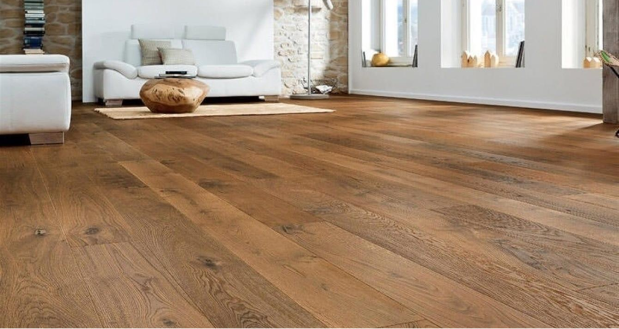
Contents
Intro
Solid wood flooring can make a home look sophisticated and beautiful as the wood has no construction or multiple layers giving a premium feel. It is a popular choice for homes because it can last for decades, it can be sanded down multiple times and refinished with hardwearing oil or lacquer, permitting you to restore the floor again and again. As a result wood flooring should last much longer than any other floor type.
How does solid wood compare?
| Solid Wood | Engineered Wood | Laminate | Vinyl | |
|---|---|---|---|---|
| Hardwearing | 2 | 3 | 4 | 5 |
| Maintenance | 5 | 4 | 1 | 1 |
| Initial Cost | 5 | 4 | 2 | 3 |
| Refinish | ||||
| Longevity | 5 | 4 | 3 | 3 |
| Easy to Clean | 2 | 2 | 4 | 5 |
| Water Resistant | ||||
| Underfloor Heating | 1 | 5* | 4 | 4 |
Key
![]() Suitable
Suitable
![]() Not Suitable
Not Suitable
*subject to floor thickness/manufacturer
(1-5) rated least to most
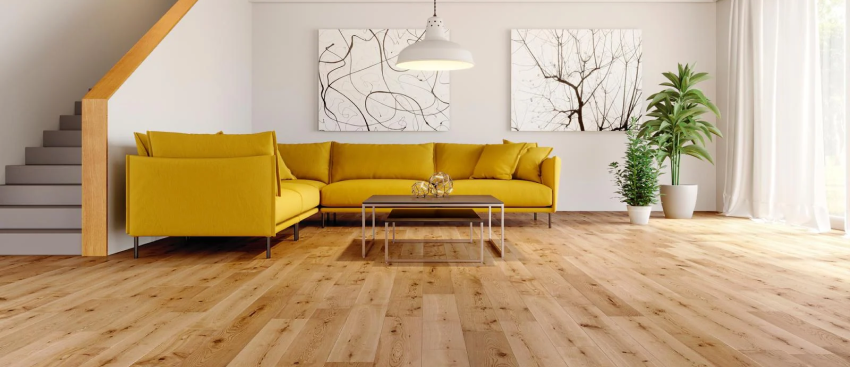
Room Suitability
Suitable Areas
![]() Living Spaces
Living Spaces
![]() Stairs
Stairs
Unsuitable Areas
![]() Kitchens
Kitchens
![]() Bathrooms
Bathrooms
Solid wood flooring is suitable for living spaces and stairs where the wood is not exposed to moisture or extreme temperature changes. It is often directly adhered to the subfloor meaning solid wood floors are not suitable for floating systems.
Unfortunately, solid wood is not suitable for kitchens or bathrooms where it can be vulnerable to splashes or fluctuations in temperature. In these environments wood can be easily damaged as it warps when exposed to water and humidity. You can create the illusion of real wood in these rooms by laying waterproof laminate or vinyl flooring. Vinyl and laminate both have wood effect design options.
There is also the possibility of laying engineered wood floors that are less prone to expanding or shrinking in conservatories or basements.
Due to the increased temperatures produced, it is not recommended to use solid wood boards as a floor covering, if you wish to install underfloor heating.
Solid Wood Finishes
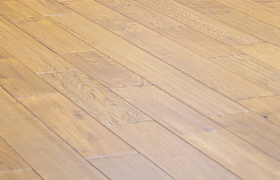
Satin Matt Lacquer
Creating a smooth, durable and glossy UV hardened finish, satin lacquers are a popular and low maintenance option. All lacquered finishes are more durable to resist splashes and scratches and help slow the colour-changing effects from sunlight.
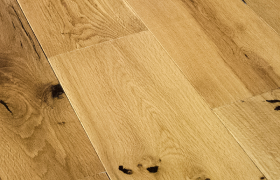
Matt Lacquer
The most popular. A natural, elegant and less Matt coating. It looks similar to an oil or wax finish, but is more scratch resistant. It combines hard wearing and low maintenance properties. All lacquer finishes are more durable and slow the colour-changing effects from sunlight when compared to oiled floors.
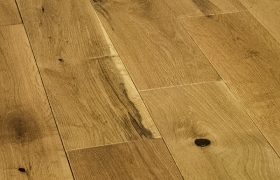
Brushed and Oiled
The most traditional treatment it gives a natural and classic look. Oil needs to be reapplied more often than lacquer, but is easy to do. Oiled floors offer less protection against sunlight. UV oiled finish combines hard wearing and low maintenance properties of lacquer with the natural look of an oiled floor.
Solid Wood Species, Style & Colour
Oak is the most popular species of wood used in solid wood flooring, it has a classic look and comes in a range of natural colours in single plank format so you can achieve a traditional look in your home.
Solid wood flooring can also be made of different species of wood such as ash and beech.
Solid Wood Edging, Thickness & Grain
Solid wood ranges can come in different edging styles:
Square edge finish: Creates a smooth surface throughout the room, combining contemporary design with the traditional look of oak wood flooring.
Bevelled/Micro bevelled: For a more traditional feel, you may wish to consider bevelled or micro bevelled edging the planks have a v-groove between the boards. With bevelled boards the groove is more pronounced.
Thickness of the board is also something to consider. A thicker board is generally higher quality and will last longer. It also gives the option of multiple re-finishing. 18mm thick boards will give a quality finish and is perfect to install over joists or a subfloor.
Solid wood floors are available in different widths, which means you have options to suit the size of your room. When it comes to the final look of the room, choosing smaller boards can create an effect making the room look bigger. Wider boards are better for larger rooms.
Solid wood floors that are rustic grade means the wood has medium to large size knots, variations in wood grain and colour, splits and mineral streaks for the most natural look. Any holes are coloured with wood filler keeping the floor smooth and even.
You may prefer a cleaner board with natural or prime grading and with less knots. These and plenty more options on all of the above characteristics are generally available to view in well stocked flooring showrooms.
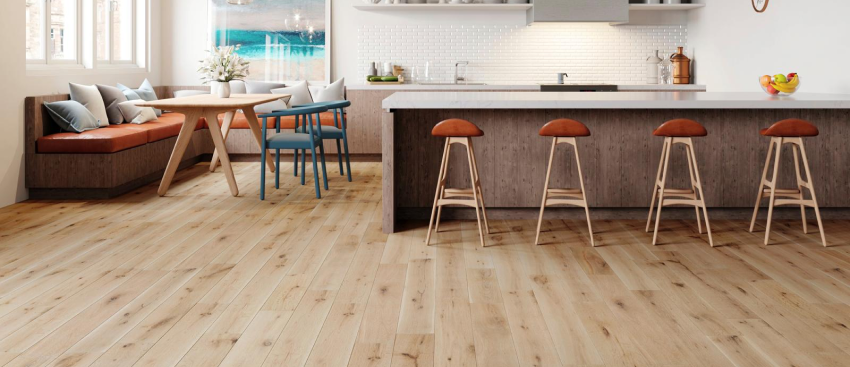
How to Lay Solid Wood Flooring?
Solid wood flooring requires qualified expertise to lay as it can be difficult to install. Please ensure that this type of flooring is installed by an experienced floor fitter or other competent professional.
What else will you need:
- Wood screws
- Wood floor adhesive
- Adhesive underlay
Required Tools:
- Mitre Saw
- Table Saw
- Tapping Block
- Hammer
- Jig Saw
- Nailer or Stapler
Acclimatising
Before your solid wood floor is installed you will need to acclimatise the boards by opening the box and leaving them in the middle of the room for 7 days. The room should be kept at a steady, normal temperature and in a humidity, moisture free environment. Ideally this would be in the area of installation to allow the best acclimatisation to occur. Please see further details in the installation manual for your chosen product.
What is the Difference Between Engineered and Solid Wood Flooring?
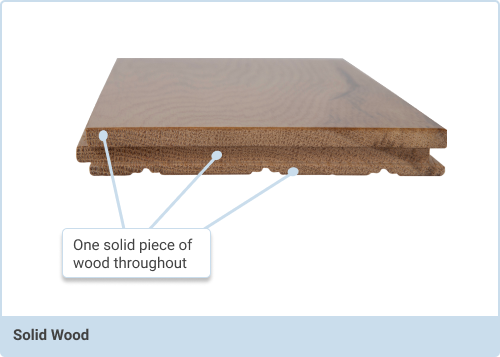
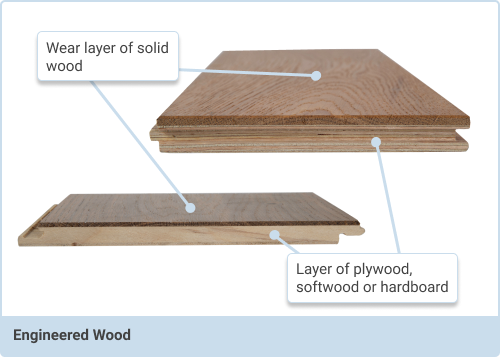
If you've already decided on using a hardwood floor in your home it can be difficult to make the final choice between engineered and solid hardwood? Here are some facts to help you decide what is best for you.
Engineered- Engineered wood flooring looks very much like solid hardwood, but its construction is very different. An engineered wood floor is constructed of layers of both hardwood and plywood, where solid hardwood consists of a solid piece of wood with no layers.
- Engineered wood flooring has durable, high-performance qualities that prevents the engineered hardwood from warping the way a solid hardwood floor might in humid and moist areas. Therefore, the engineered construction allows for installation in most areas of the home, including conservatories and basements.
- Engineered hardwood offers easier care and maintenance.
- Engineered flooring is somewhat less expensive than solid hardwood, however there is a limit to the number of times it can be sanded and refinished as the surface hardwood layer is relatively thin and depends on the thickness of the board.
- A hardwood veneer and its finish gives a natural look to the engineered floor just as a solid hardwood floor does.
- Suitable for floating systems.
- Solid wood flooring can be sanded and refinished many times over the course of its lifespan, meaning greater longevity that far surpasses engineered flooring.
- Generally not suitable for floating systems.
- Generally adhered to subfloor using flexible adhesives.
- Premium feel.
Your choice depends on what you are looking to achieve in your home and how much you value each of the floorings advantages.
How to Clean Solid Wood Floors?
Solid wood flooring requires regular maintenance to avoid the surface becoming dull and scratched. Dirt can build and lead to staining, therefore it is important to frequently vacuum or sweep up. It is recommended that you minimise the amount you mop solid wood flooring because excess water can cause warping. If necessary, you should use a damp mop with hot water that will evaporate easily.
In order to protect the wood further, it is common to apply lacquer or varnish. This process creates a protective layer and also provides a pleasing shine. Both lacquer and varnish can become discoloured and damaged over time so you should consider refreshing it accordingly, this can be easily done with a clear lacquer spray. There are lots of high-performance wood floor cleaners, one such example is Osmo Wash & Care, a cleaning concentrate that works great for waxed and oiled floors. You may want to apply wax in order to restore any shine lost over the years.
Everyday activities can cause scratches on your flooring. Try not to wear high heels indoors and place your furniture on rugs or furniture pads. The beauty of wood flooring is that you can sand and refinish it as much as you like so scratches needn’t be a permanent fixture. Additionally, if you need a quick fix you could try out wood stain markers.
